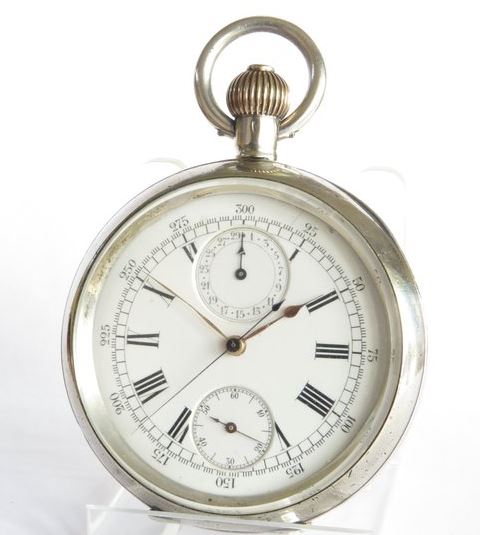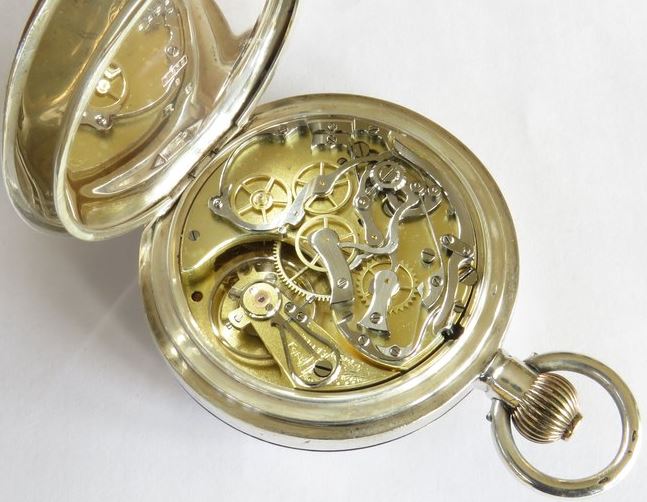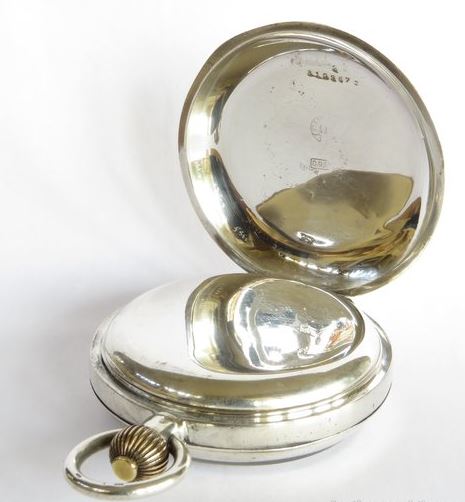Last updated on June 11, 2024
I prefer my watches to be simple and do just one thing, tell the time. My collection doesn’t contain any watches with complications. I do own a G-Shock with a number of different complications, but that is a sports watch and certainly not an antique. Amongst, other things the added complications increase the cost of servicing. However, that doesn’t mean I am not interested in antique watch calculations and sometimes I just enjoy researching the timepiece. In this case, I stumbled across this Omega chronograph 19’’’ watch for sale at one of my preferred suppliers, The Vintage Wrist Watch Company.

19’’’ CHRO movement
The watch has a Swiss made 19’’’ CHRO stem-winding movement, understood to be Grade C, which works well. The Omega 19’’’ pocket watch was introduced in 1894. It was followed by the chronograph version, the 19’’’ CHRO in 1898. The chronograph version was available in a variety of grades:
- A: 7 jewels, flat hairspring, compensating balance.
- B: 15 jewels, Breguet hairspring, compensating balance.
- C: 15 – 19 jewels, regulator adjuster with screw or snail-star wheel, 7-8 collets.
- CC: Fine C quality.
- CCC: Very fine CC quality for 19 and 20”’
- CCR: Extra fine CC quality for 19 and 20”’
- CCCR: 23 jewels, 15 collets for 19 and 20”’, official chronometer.
- DDR: 23 jewels, 18 collets for 19 and 20”’, official chronometer, after 1922 signed Very Best.
In this instance, the movement is a Grade C, which is middle of the range, but still a high-quality movement with 15 – 19 jewels. The watch had a power reserve of 38 hours straight out of the box. The watch is wound and the time is set by using the traditional crown at 12 o’clock. The chronograph is operated by depressing the small button on the top of the crown, which triggers the central sweep hand. Press it again and it stops. Press again and it resets to zero. This is a 1/5th of a second timer and a second sunken sub-dial displays the elapsed time for up to 30 minutes.

18’’’ CHRO movement
The 19’’’ CHRO was followed by the 18’’’ CHRO which was introduced in 1906. The 18” CHRO had a mono-pusher pocket watch chronograph movement, where the start, stop and reset are all activated by a pusher button on the case below the 6 o’clock marker. This movement was famously used by Omega to create the world’s first wristwatch chronograph in 1913.
The watch measures 53mm in diameter excluding the winding stem and the loop. There were many variations of both the dial and case. The 19’’’ CHRO movement was produced in both an open-face and hunter configuration. However, in this case, it is the open-face or Lépine version. For pocket watches, the Lépine or open-face calibre denotes a structure in which the second hand is in line with the winding stem. In contrast, the hunter calibre has the second hand on a right angle to the winding stem.
Silver case
The case is silver and there are continental hallmarks for 935 silver inside both of the case backs. 935 silver has a slightly higher purity than Sterling silver which is 925. The hinged case bezel opens to reveal the enamel dial. The hinged case-back opens to reveal a matching dust cover which, in turn, hinges open to expose the 19’’’ CHRO movement. The inner back cover also has the early Omega logo although it is quite rubbed and faint. The case has a 0.5cm indentation to the side and the odd minor mark. However, overall the condition is very acceptable for such an early piece and would be considered to be excellent or near mint. The glass crystal is also in excellent condition and free of any chips or scratches.

The original white enamel dial is in excellent condition with no hairline cracks or signs of repairs. The outer chapter of the dial runs to 300. Therefore, one complete rotation of the timer hands equals 1 minute or 300 x 1/5ths of a second. Within this is the technical index with 1/5th-second markers. Next are the railroad chapter markings followed by the Arabic hour markers 1 to 12.
There were various options with regards to the design of the dial, and this particular dial is not signed, this is quite normal, particularly if the retailer wanted the option of adding their own details. The watch has the original hands, however, the minute hand is slightly out of shape. Two subsidiary dials, one to record up to 30 minutes and the other for constant seconds. There was also another version of this watch where the Chrono minutes sub-dial was 15 minutes instead of 30.
Summary
As I stated in the opening paragraph, I have no practical use for antique watches with complications. However, I was really interested in studying the history of the Omega chronograph 19’’’ movement. The launch of this movement signalled a commitment by Omega to sports timekeeping. Officially, Omega became involved as the official timekeeper at a number of Swiss events in 1905. Omega has been the official timekeeper at the Olympics since 1932.
Really interesting piece. I have a B Grade Omega chronograph 19 pocket watch with 15 jewels. Its been passed down through the family, It still works. Thanks for all of the additional information.
I have a B Grade Omega chronograph 19 pocket watch with 15 jewels, unfortnately it doesn’t work. Is it worth repairing? I can’t think of a practical use for it. Generally, it just sits in a cabinet as a talking piece.
Hi Robin, I am assuming that both the timekeeping and chronograph complication is not working. It will probably be an expensive option to get it fixed, but it may well be worth it if it is a family heirloom that future generations can enjoy. There is a list of accredited repairers at the British Horological Insitute. I hope this helps, Jason